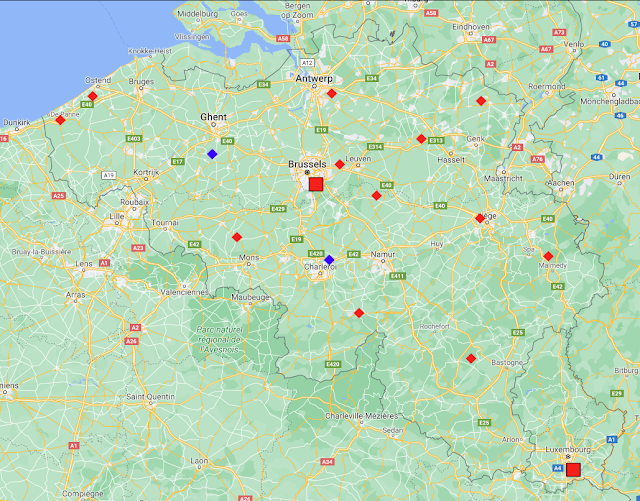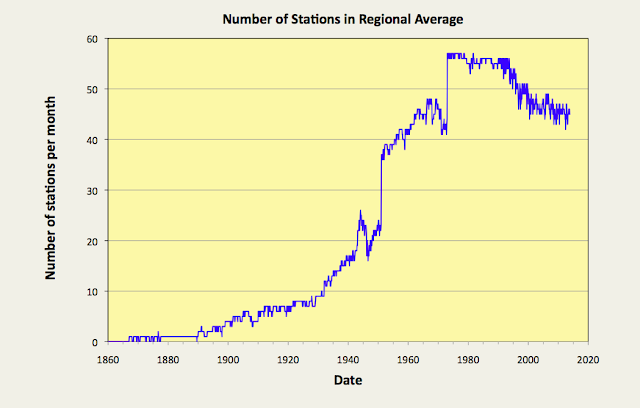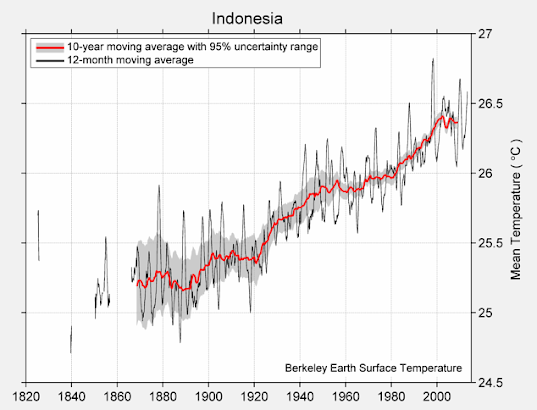The longest temperature records that we have are almost all found in Europe. In fact Europe has over 30 records that predate 1800, and three that go back beyond 1750. One of those three is the De Bilt record from the Netherlands (Berkeley Earth ID: 175554) that I discussed in both Post 41 and Post 42 and which dates back to 1706. The second is Uppsala in Sweden (Berkeley Earth ID: 175676) which dates back to 1722, and the third is Berlin-Tempelhof in Germany (Berkeley Earth ID: 155194) which has data as far back as 1701. Overall, there are nearly 120 temperature records with over 1200 months of data that also have data that predates 1860 (see here for a list). If we average the anomalies from these records, we get the temperature trend shown in Fig. 44.1 below.
To construct the trend in Fig. 44.1 above the raw temperature data from each of 109 records was first converted to monthly anomaly data by subtracting the monthly reference temperatures (MRTs). The MRTs were in turn calculated for the time interval 1951-1980 by averaging the data in that record over all months in that period. This is the same time frame that was used by climate scientists in the 1980s to analyse temperature data, but is significantly earlier than the time intervals normally used today which tend to be 1961-1990 or 1981-2010. The reasons for the differences in time frame I intend to discuss in a later post.
The temperature trend in Fig. 44.1 has two features of note. The first is the very slight upward trend from 1730 to 1980 of approximately 0.10 °C per century. This amounts to a total temperature increase over that time period of about 0.25 °C which is significantly less than the standard deviation of the 10-year moving average of the same data. This suggests that this trend is insignificant when compared to natural variations in temperature.
The second feature is the sudden temperature rise of almost 0.8 °C seen in 1988. This looks unnatural. So much so that, if it were to occur in just one temperature record, then it could be ascribed to a random fluctuation, or a sudden change in the local environment or undocumented location change. But this is not seen in just one record; it is seen in the average of over 100 temperature records, as the data in Fig. 44.2 below shows.
Fig. 44.2: The number of sets of station data included each month in the temperature trend for Europe.
Nor can we claim that this is just a local effect. The map below in Fig. 44.3 shows the approximate location of all 109 stations whose data was used to construct the trend in Fig. 44.1 above. While it is clear that the greatest concentration of stations is in central Europe between France and Poland, it is also evident that there are significant numbers of stations with very long records located on the edges of Europe such as in the UK, Scandinavia and eastern Europe. This suggests that the sudden rise in temperature seen in 1988 is real and widespread.
For comparison, I have performed the same averaging process on the adjusted data for each station created by Berkeley Earth. This adjusted data for each station incorporates two adjustments to the data. Firstly, the monthly reference temperatures (MRTs) are constructed from homogenized data for the region rather than from the raw station data. Secondly, the trend of each temperature record is spliced into segments using breakpoints, and each segment is adjusted up or down relative to its original position. These breakpoint adjustments are supposed to remove local measurement errors (such as those due to changes in instrumentation or location) and thus make the data more reliable, but as I pointed out in my previous post, reliability in temperature data is very hard to measure due to the amount of natural variability that it contains.
Fig. 44.4: Temperature trends for all long and medium stations in Europe since 1750 derived by aggregating and averaging
the Berkeley Earth adjusted data. The best fit linear trend line (in
red) is for the period 1801-1980 and has a gradient of +0.33 ± 0.03
°C/century.
The results of averaging the Berkeley Earth adjusted data are shown in Fig. 44.4 above. Three things are noticeable in this data. Firstly, the trend in the data before 1980 has increased by a factor of three. There are two main reasons for this. One reason is that the adjustments made to the data have increased the trend slightly and smoothed out some of peaks before 1830 (see Fig. 44.6 below). The other is that the interval used for the fitting of the linear regression is shorter. This in turn reduces the gradient of the trend.
The second feature of the data in Fig. 44.4 above is that the jump in temperature after 1988 is still present, and is just as large as that seen in Fig. 44.1.
The third feature of the data in Fig. 44.4 is that it closely resembles that data shown for the 12-month and 10-year trends that has been published by Berkeley Earth (see Fig. 44.5 below). This suggests that the averaging process I have used is sufficiently accurate without the need to apply different weightings to the data from different stations as Berkeley Earth does. The weightings that Berkeley Earth use are supposedly to correct for any clustering of stations, but the map in Fig. 44.3 suggests these weightings are not likely to vary significantly for most stations, and so are not likely to be of primary importance. The agreement between the data in Fig. 44.4 and that in Fig. 44.5 appears to confirm that hypothesis.
Fig. 44.5: The temperature trend for Europe since 1750 according to Berkeley Earth.
It can be seen from these results that the differences between the trends I have constructed using the original data and the trends derived using Berkeley Earth's adjusted data are not as large as has been seen in previous regional analyses, such as those for South Africa (Post 37), South America (Post 35), the South Pacific (Post 33 and Post 34), Papua New Guinea (Post 32), Indonesia (Post 31), Australia (Post 26) and New Zealand (Post 8). These differences for Europe are shown in Fig. 44.6 below.
Fig. 44.6: The contribution of Berkeley Earth (BE) adjustments to the anomaly data in Fig. 44.4 after smoothing with a 12-month moving average. The linear best fit (red line) to the breakpoint adjustment data (shown in orange) is for the period 1841-2010 and has a gradient of 0.057 ± 0.001 °C per century. The blue curve represents the total BE adjustments including those from homogenization.
Overall, the adjustments made by Berkeley Earth to their data have probably only added about 0.2 °C to the warming. More significant are the adjustments made to data before 1830 which appear to be designed to flatten the curve. Such adjustments, though, assume that the mean temperature before 1830 was stable. Yet data from 1830 to 1980 suggests that the temperature trend for Europe was anything but stable, even though the trend shown in Fig. 44.1 was constructed from between 50 and 109 different datasets over that period. The full extent of that instability for the 5-year average temperature can be seen in Fig. 44.7 below.
Fig. 44.7: The 5-year moving average of the temperature trend for Europe since 1700. The best fit is applied to the monthly anomaly data for the interval 1731-1980 and has a positive gradient of +0.10 ± 0.04 °C per century.
Conclusions
In 1981 James Hansen and co-workers at NASA's Goddard Institute for Space Studies (GISS) published a paper in the pre-eminent journal Science (which incidentally, has an impact factor of 41.8, where impact factors over 1.0 are considered good) that was one of the first to warn of the impact that increased levels of carbon dioxide in the atmosphere could have on global warming and climate change. But here is the problem: the data shown here appears to indicated that there was no significant warming in Europe before 1981. As the data shown in Fig. 44.1 indicates, the total warming in Europe for the 250 years before 1981 was so small (less than 0.25 °C) that it was less than the natural variation in the mean decadal temperatures over the same period.
Then, in 1988 the mean temperatures in Europe suddenly jumped by over 0.8 °C (see Fig. 44.1), just in time for the IPCC's first assessment report on climate change in 1990 (PDF). A similar abrupt jump was seen at about the same time in Botswana and, to a lesser extent, in South Africa. Convenient, certainly. But is this just coincidence or 20:20 foresight by the IPCC?
As I have shown throughout the course of this blog, before 1981 there does not appear to have been any exceptional warming in most of the Southern Hemisphere either. So the above analysis raises important concerns regarding the reported extent of climate change in Europe and beyond. The most important question is: is the temperature rise seen after 1988 in Fig. 44.1 real? And if so, what is causing it?
If it is being driven by CO2, then why does it not correlate with increases in CO2 levels in the atmosphere? If it is a natural phenomenon, why are there no other jumps of a similar magnitude in the previous 250 years? Could it be another example of chaotic behaviour similar to the self-similarity I explored in Post 42? And if so, is it just random, or is it the consequence of a complex system being driven between meta-stable states by, for example, greenhouse gases? What I don't see so far is conclusive evidence either way.
















































